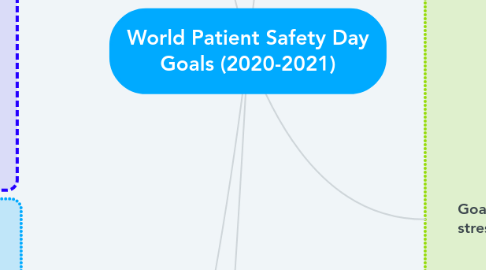
1. Goal 3: Improve the use of personal protective equipment (PPE)
1.1. Suggested action 1: Minimize the need for PPE
1.1.1. use physical barriers
1.1.2. Bundling activities to minimize the number of times a room is entered
1.1.3. Consider using specific PPE only
1.2. Suggested action 2: Environmental and engineering controls
1.2.1. Adequate supplies of water for hand hygiene etc
1.2.2. Management of reusable and disposable PPE
1.2.3. Cooling and rehydrating facilities for use
1.2.4. Ensure cleaning and disinfection procedures
1.2.5. Ensure that heating, ventilation, and air-conditioning systems are managed
1.3. Suggested action 3: Administrative controls
1.3.1. Conduct risk assessments
1.3.2. Provide mandatory training on policies and procedures
1.3.3. Implement protocols for reporting
1.3.4. Stock management
1.3.5. PPE easy accessibility
1.3.6. Control the quality of PPE
1.4. Suggested action 4: Work practice controls
1.4.1. Correct usage of PPE
1.4.2. Base glove selection
1.4.3. Avoid any contact between contaminated PPE and surfaces
1.4.4. Ensure infectious waste containers are available
1.4.5. Discard the used PPE in appropriate disposal bags
1.5. Suggested action 5: Personal controls
1.5.1. Perform hand hygiene
1.5.2. Ensure that works undergo practical training
1.5.3. Discard used PPE
1.5.4. Do not share PPE
1.5.5. Report any breach of or non-adherence to PPE practices
2. Goal 4: Promote zero tolerance of violence against health workers
2.1. Suggested action 1: Elimination of threats or hazards
2.1.1. Conduct a facility security review
2.1.2. Regulate public access to the main health care facility
2.1.3. Maintain links with the local police
2.2. Suggested action 2: Environmental and engineering controls
2.2.1. Maintain good illuminations to improve visibility in all areas
2.2.2. adequate temperature, humidity and ventilation
2.2.3. Provide treatment rooms with two exits
2.2.4. Carry out security screening of visitors
2.2.5. Alarm systems
2.2.6. Provide ideal seating arrangements
2.2.7. Protective barriers for workers
2.3. Suggested action 3: Administrative controls
2.3.1. Organize rapid response teams
2.3.2. Conduct routine assessment of incidents of workplace violence
2.3.3. Compile, distribute, & apply codes of conduct
2.3.4. Report all incidents involving physical or psychological violence
2.4. Suggested action 4: Work practice controls
2.4.1. Provide workers with clear instructions and training
2.4.2. Involve community leaders
2.4.3. Arrange duty rosters
2.4.4. Respect the privacy of patients
2.4.5. Ensure that night shift workers work together or in close proximity to each other
2.5. Suggested action 5: Personal controls
2.5.1. Good rapport with patients' or victims' families
2.5.2. Show respect for tradition without compromising safety
2.5.3. Escalate any violent behaviours
2.5.4. Seek guidance and counselling
2.5.5. Maintain physical fitness and a stable emotional state
3. Goal 5: Report and analyse serious safety-related incidents
3.1. Suggested action 1: Minimizing the barriers to report
3.1.1. Replace paper forms with e-methods of reporting
3.1.2. Remove the fear of blame and retribution from the culture of reporting
3.2. Suggested action 2: Environmental and engineering controls
3.2.1. Establish a telephone hotline
3.2.2. Implement a coding system based on ICD-11
3.3. Suggested action 3: Administrative controls
3.3.1. Create a positive environment for reporting
3.3.2. Operationalize a patient safety incident reporting system
3.3.3. Communicate clear guidance for staff on what should be reported
3.3.4. Make mandatory immediate reporting
3.3.5. Establish safety incident review committees
3.3.6. Give staff regular feedback on progress with the investigation of the incident
3.4. Suggested action 4: Work practice controls
3.4.1. Ensure periodic review of all serious safety incident reported
3.4.2. In-depth systemic analysis
3.4.3. Calculate and report risk-adjusted mortality
3.4.4. report occupational safety incidents
3.5. Suggested action 5: Personal controls
3.5.1. Train all patient care staff on never event and sentinel event policies
4. Goal 1: Prevent sharps injuries
4.1. Suggested action 1: Elimination of threats or hazards
4.1.1. Eliminate unnecessary injections
4.1.2. Maximize the use of needle-less intravenous systems
4.2. Suggested action 2: Environmental and engineering controls
4.2.1. Use safety-engineered devices (needles that retract, sheathe, or break or blunt immediately after use)
4.2.2. Use syringes with a reuse prevention feature
4.2.3. Use sealable, puncture-resistant, leak-proof, colour-coded sharps containers
4.3. Suggested action 3: Administrative controls
4.3.1. Implement policies and training programmes on how to limit exposure to hazards
4.3.2. Implement a surveillance system
4.3.3. Institute a working group focused on injection safety implementation
4.3.4. Provide pre-service and ongoing immunization against hepB etc.
4.4. Suggested action 4: Work practice controls
4.4.1. Place sharps containers at eye level and at arm's reach
4.4.2. Schedule check on the sharp containers
4.5. Suggested action 5: Personal controls
4.5.1. Avoid recapping and manipulations of needles after usage
4.5.2. Report any incident and accident linked to a needle or sharps injury
4.5.3. Follow WHO recommended 7 steps that make every injection safe
5. Goal 2: Reduce work-related stress and burnout
5.1. Suggested action 1: Elimination of threats or hazards
5.1.1. Map all psychosocial hazards and assess their risks
5.1.2. Establish clear lines of authority and responsibility to reduce stress by eliminating confusion
5.1.3. Ensure optimal layout and work processes
5.2. Suggested action 2: Environmental and engineering controls
5.2.1. Mitigate the effects of extreme temperatures
5.2.2. Good lighting (environment)
5.2.3. Good hygiene, cleaning, disinfection and ventilation
5.3. Suggested action 3: Administrative controls
5.3.1. Implement a programme to monitor and detect psychosocial risks
5.3.2. Establish policies regarding work hours and shifts
5.3.3. Establish channels and officers for reporting concerns
5.4. Suggested action 4: Work practice controls
5.4.1. Opportunities for exercises and recreation
5.4.2. Open-culture
5.4.3. Practice team-building techniques
5.4.4. Introduce a buddy system
5.4.5. Rotate works from high stress to lower-stress function
5.4.6. Sufficient breaks
5.5. Suggested action 5: Personal controls
5.5.1. Self-care activities
5.5.2. Contact and consult your occupational health and mental health professional (and counselling)
